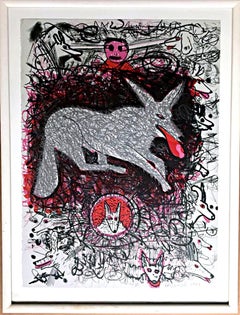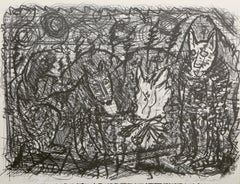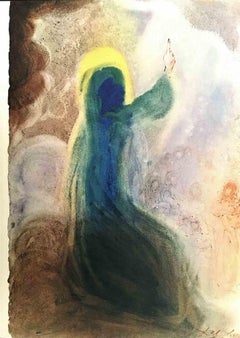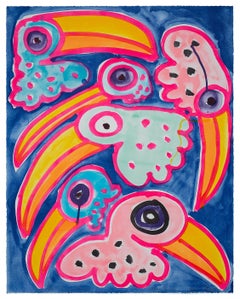Roy De Forest Animal Prints
to
1
1
1
Overall Width
to
Overall Height
to
2
1
6
194
161
118
99
3
3
2
1
1
1
3
1
1
1
1
1
1
3
Artist: Roy De Forest
Roy De Forest, Dog lithograph, signed/n by world renowned California pet painter
By Roy De Forest
Located in New York, NY
Roy De Forest
Untitled (Dog), 1981
Color lithograph with deckled edges. Floated and framed.
Pencil signed and numbered from the edition of 125
Frame Included: held in original vintage white frame
Wonderful whimsical rare 1981 lithograph by the incredibly popular and beloved Roy de Forest, famous for his paintings and prints of dogs...
Category
1980s Surrealist Roy De Forest Animal Prints
Materials
Lithograph
Dogs at Campfire, Surrealist Lithograph by Roy De Forest
By Roy De Forest
Located in Long Island City, NY
Roy De Forest, American (1930 - 2007) - Dogs at Campfire, Year: circa 1980, Medium: Lithograph on Arches, signed and numbered in pencil, Edition: Shop Proof, Size: 18 x 23 in. (4...
Category
1980s Surrealist Roy De Forest Animal Prints
Materials
Lithograph
Untitled Signed lithograph on Arches paper by world famous dog artist, unique TP
By Roy De Forest
Located in New York, NY
ROY DE FOREST
Untitled, 1981
Lithograph on Arches paper with four deckled edges.
22 1/2 × 30 inches
Hand signed and annotated Trial Proof, aside from the regular edition of 60
Unfra...
Category
1980s Contemporary Roy De Forest Animal Prints
Materials
Archival Paper, Pencil, Graphite, Lithograph
Related Items
Beati Pauperes...Beati Mites...Beati - Lithograph - 1964
By Salvador Dalí
Located in Roma, IT
Beati pauperes...beati mites...beati is an artwork realized in 1964.
It is part of Biblia Sacra vulgatæ editionis published by Rizzoli-Mediolani between 1967 and 1969.
Color lithog...
Category
1970s Surrealist Roy De Forest Animal Prints
Materials
Lithograph
$380 Sale Price
40% Off
H 18.9 in W 13.78 in D 0.04 in
Toco Toucan Tucano
By Katherine Bernhardt
Located in London, GB
Toco Toucan Toucano (2020)
Edition of 150
Nine colour lithographic print on Somerset Velvet 300 gsm.
Signed, numbered, and dated by the artist
Katherine Bernhardt is a contemporar...
Category
2010s Contemporary Roy De Forest Animal Prints
Materials
Lithograph
Turtle - Original Lithograph by Carlo Quattrucci - 1971
By Carlo Quattrucci
Located in Roma, IT
Turtle is an original artwork realized by Carlo Quattrucci in 1971.
Hand Signed and dated on the lower right margin.
Numbered on the lower left. Edition of 70 pieces plus some Arti...
Category
1970s Contemporary Roy De Forest Animal Prints
Materials
Lithograph
$329
H 19.69 in W 25.6 in D 0.08 in
Marino Marini - Knight - Original Lithograph
By Marino Marini
Located in Collonge Bellerive, Geneve, CH
Marino Marini - Knight - Original Lithograph
1968
Dimensions: 32 x 48 cm
From the art review XXe siècle
Unsigned and unumbered as issued
Category
1960s Surrealist Roy De Forest Animal Prints
Materials
Lithograph
Marc Chagall - The Green Horse - Original Lithograph
By Marc Chagall
Located in Collonge Bellerive, Geneve, CH
Marc Chagall
Original Lithograph
Title: The Green Horse
1973
Dimensions: 33 x 50 cm
Reference: This lithograph was created for the portfolio "Chagall Monu...
Category
1970s Surrealist Roy De Forest Animal Prints
Materials
Lithograph
$1,644
H 13 in W 19.69 in D 0.04 in
Marino Marini - Horses - Original Lithograph
By Marino Marini
Located in Collonge Bellerive, Geneve, CH
Marino Marini - Horses - Original Lithograph
1951
Dimensions: 32 x 24 cm
From the art review XXe siècle
Unsigned and unumbered as issued
Category
1950s Surrealist Roy De Forest Animal Prints
Materials
Lithograph
Osage Sheep State II (~30% OFF LISTING PRICE)
By Theodore Waddell
Located in Kansas City, MO
Theodore Waddell
Osage Sheep State II
Year: 1994
Color Lithograph
Edition: 30
Papers: Arches Cover, Black
Paper Size: 22.5 x 30 inches
Image Size: Same
Signed and numbered by hand
CO...
Category
1990s Contemporary Roy De Forest Animal Prints
Materials
Lithograph
$1,268 Sale Price
29% Off
H 22.5 in W 30 in
NEW INTERNATIONAL ECONOMIC ORDER Signed Serigraph, Peace Dove, Hands, Fruit
By Chaim Gross
Located in Union City, NJ
"NEW INTERNATIONAL
ECONOMIC ORDER" is a brightly colored serigraph by the American artist/sculptor Chaim Gross printed in 16 colors including shades of yellow, blue, purple, salmon p...
Category
1970s Contemporary Roy De Forest Animal Prints
Materials
Lithograph
$126 Sale Price
35% Off
H 8.5 in W 11 in
Salvador Dali, American Trotting Horses No. 2, Lithograph with collage
By Salvador Dalí
Located in Long Island City, NY
Artist: Salvador Dali
Title: American Trotting Horses No. 2
Date: 1971
Portfolio: Currier & Ives as Interpreted by Salvador Dali
Medium: Litho...
Category
1970s Surrealist Roy De Forest Animal Prints
Materials
Mixed Media, Lithograph
$7,500
H 21.5 in W 30 in
HOPI EAGLE DANCE Signed Lithograph, Abstract Dance Portrait, Native American
By Dan Namingha
Located in Union City, NJ
HOPI EAGLE DANCE is an original hand drawn, limited edition lithograph by the prominent Native American artist Dan Namingha, a member of the Hopi tribe. H...
Category
1990s Contemporary Roy De Forest Animal Prints
Materials
Lithograph
$1,998
H 32.5 in W 27.25 in
Jean Arp - Original Lithograph
By Jean Arp
Located in Collonge Bellerive, Geneve, CH
Jean Arp - Original Lithograph
1962
Dimensions: 32 x 24 cm
From the art review XXe siècle
Unsigned and unumbered as issued
Category
1960s Surrealist Roy De Forest Animal Prints
Materials
Lithograph
Butterflies, Jan 25, 2006
By Donald Sultan
Located in Fairfield, CT
Yellow Poppies is a natural companion for Red Poppies, March 21, 2012 and is equally strong installed solo. The multi-layered cropped poppies bleed to the paper edge and mimic the su...
Category
Early 2000s Contemporary Roy De Forest Animal Prints
Materials
Paper, Ink
Roy De Forest animal prints for sale on 1stDibs.
Find a wide variety of authentic Roy De Forest animal prints available for sale on 1stDibs. You can also browse by medium to find art by Roy De Forest in lithograph and more. Much of the original work by this artist or collective was created during the 1980s and is mostly associated with the Surrealist style. Not every interior allows for large Roy De Forest animal prints, so small editions measuring 27 inches across are available. Customers who are interested in this artist might also find the work of Will Barnet, Pedro Friedeberg, and Nura Ulreich. Roy De Forest animal prints prices can differ depending upon medium, time period and other attributes. On 1stDibs, the price for these items starts at $1,700 and tops out at $2,800, while the average work can sell for $2,250.




